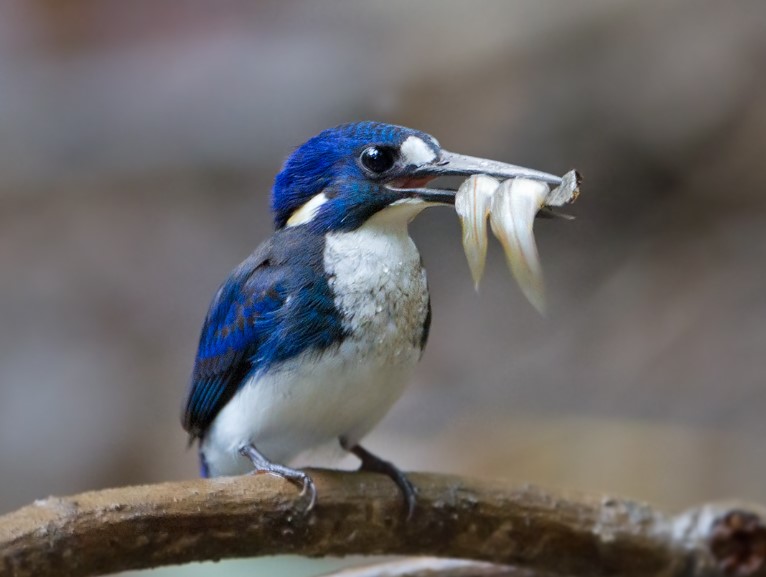In Australia, Little Kingfishers belong to the subfamily Alcedininae and are midget Gem-like kingfishers. Rarely seen, it lives in remote habitats alone, unobtrusive, and sedentary. The bird is similarly confined to streamside vegetation and is usually seen perched on low branches over the water like the Azure species.
Despite its fixed gaze, it occasionally bobbles its head as it waits for its prey, a small fish, crustacean, or aquatic insect. Upon seizing prey, it dives into the water and eats it from the perch. Flying low over the water and through forests like the Azure, the Little Kingfisher flies fast.
Nest-building appears to be a collaborative effort between both sexes. Their bills are used to drill and excavate tunnels 150 millimeters long in mud mounds, banks of streams, or the base of rotting stumps and low termite mounds. Cast fish skeletons and scales litter the nesting chamber formed by the enlargement of the tunnel. Other fishing kingfishers, including the Azure, may have similar breeding habits to the Little Kingfisher. In addition to its 30 mm bill, the Little Kingfisher measures 120-130 mm in length. There is no difference between the sexes.

On the forehead and neck, there is a white spot on each side, with the head and upper surface shining royal blue, sometimes tinged turquoise. There is a dusky black tint to the flight feathers, unlike the back feathers. A very short tail with a royal-blue top and a dusky bottom. There are varying shades of royal blue on the flanks and sides of the breast.
The eye is dark brown. The bill is black. A dark brown foot with two toes on the front. Like adults, immature kingfishers have a dusky turquoise-grey upper body and dark grey-blue crown. Spots on the forehead and neck that are orange in color. Black on the breast and scalloped underparts. Turquoise-grey to black colors covers the sides of the neck, breast, and flanks.
Little Kingfishers call in a shrill, sharp, high-pitched whistle. The sound of the Azure Kingfisher is sometimes repeated rapidly but at a higher pitch. It is usually given by both sexes when disturbed or in flight. Northern Australia’s nesting and breeding season last from October to March, during the wet months. There is probably one brood per season. The tunnel is usually built between the roots of a streamside tree, a mangrove tree, or a low termite mound near ground level.
There are five or six smooth, glossy, pearly white eggs laid by Little Kingfishers. They are almost spherical, measuring 17 x 14 mm. Both sexes participate in the incubation process. From Joseph Bonaparte Gulf to Roper River, and from the Cape York Peninsula south to near Normanton on the west coast, this attractive kingfisher can be found in the coastal Northern Territory.
In the eastern part of its range, kingfishers live along densely mangrove-lined estuaries, ranging inland along small rainforested creeks to nearby tablelands. A native race and a non-native race live in Australia. In Arnhem Land and along the west coast of Cape York Peninsula, one is bright turquoise-blue and small; in coastal east Queensland south of Cape York Peninsula, the other is rich royal blue and larger. Cape York Peninsula’s east coast has intergraded populations.
Read More – The Crested Kingfisher (Megaceryle lugubris)







